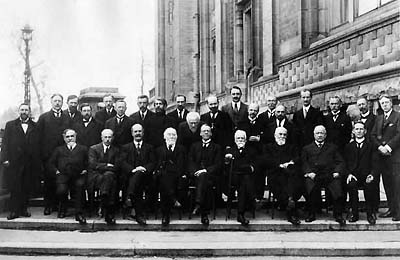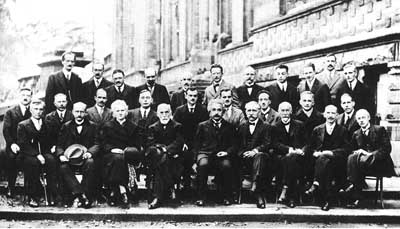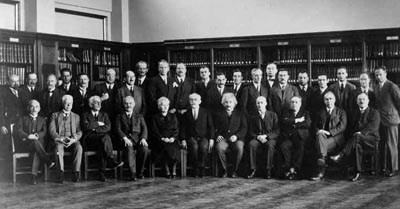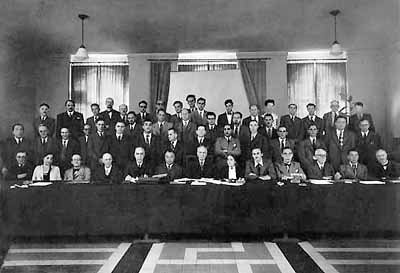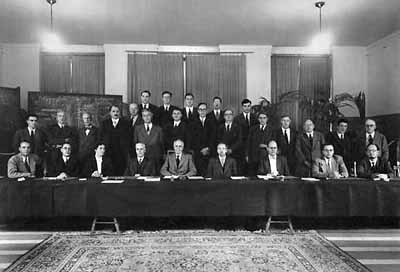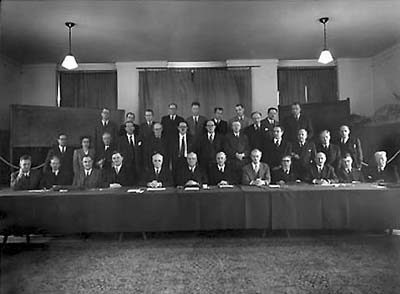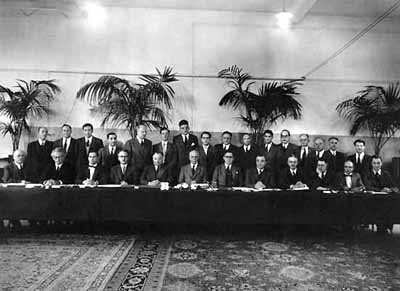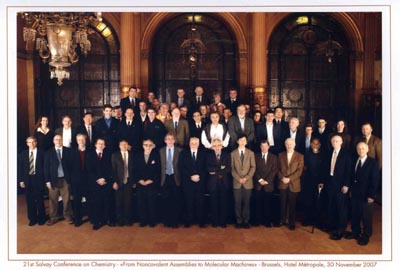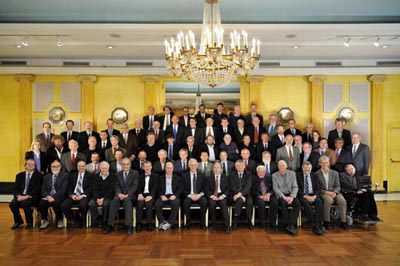Quelques réunions de Solvay en images
Table des conférences de Physique - The Solvay Conferences in Physics
Les réunions (en bleu la physique, en rouge la chimie) et les photos sont détaillées ci-dessous
|
Inquire after laws in complex systems
|
Search for the last constituens of matter (physics
and chimist)
|
Exploration of our environment at large
|
|
First World War
|
||
|
Second World War
|
||
| 9. Neuvième Conseil de Chimie (1953) | ||
|
13.
The Structure and Evolution of Galaxies (1964)
|
||
|
14.
Fundamental Problems in Elementary Particle Physics (1967)
|
||
|
15. Symmetry
Properties of Nuclei (1970)
|
||
|
16. Astrophysics
and Gravitation (1973)
|
||
|
17. Order
and Fluctuations in Equilibrium and Non - Equilibrium Statistical Mechanics
(1978)
|
||
| 18. High Energy Physics. What are the Possibilities for Extending our Understanding of Elementary Particles and their Interactions to Much Greater Energies? (1982) | ||
|
19. Surface
Science (1987)
|
||
|
20. Quantum
Optics (1991)
|
||
|
21. Dynamical
Systems and Irreversibility (1998)
|
||
|
22. The
Physics of Communication (2001)
|
||
| 23. Structure quantique de l'espace et du temps (2005) | ||
| 21. 21ième conférence de chimie (2007) | ||
| 24. Théorie quantique de la matière condensée (2008) | ||
| 22. 22ième conférence de chimie (2010) | ||
| 25. The theory of the quantum world (2011) | ||
| | ||
| En 1911 se tint le premier Conseil Solvay, consacré au rayonnement et aux quanta. Ces conférences doivent leur nom à Ernest Solvay, inventeur d'une méthode industrielle de préparation de la soude. Il fonda et finança une série de réunions internationales de physique dont les thèmes étaient définis à l'avance et auxquelles les principaux physiciens du domaine retenu étaient conviés. Ces conférences, limitées à une trentaine de participants, avaient lieu à Bruxelles. La participation réduite à ces conférences et la liste des invités à la première furent en grande partie établies par H.Walter Nernst. | ||
|
Théorie des rayonnements et
des quanta | Radiation
Theory and the Quanta | |
| 1911 | 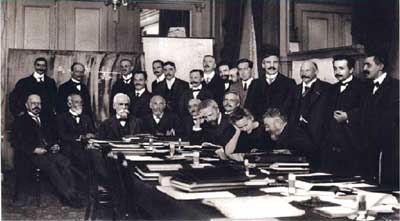 |
Debout de gauche à droite : O.Goldschmidt, M.Planck, H.Rubens, A.Sommerfeld, T.Lindemann, M.de Broglie, M.Knudsen, F.Hasenöhrl, H.Hostelet, T.Herzen, J.Jeans, E.Rutherford, H.Kamerlingh Onnes, A.Einstein, P.Langevin. Assis de gauche à droite : W.Nernst, M.Brillouin, E.Solvay, H.Lorentz, E.Warburg, J.Perrin, W.Wien, M.Curie, H.Poincaré. |
| Cliquez sur la photo
pour l'agrandir | ||
|
In 1911 the idea of national and international conferences dealing with scientific
matters, was about a century old. | ||
|
Structure
de la matière
|
The
Structure of Matter
|
|
| 1913 | 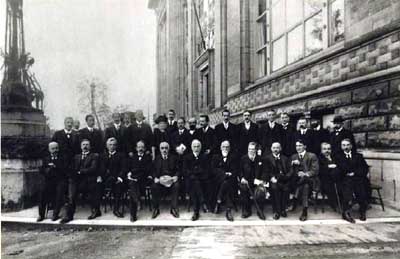 |
Assis de gauche à droite : Nernst, Rutherford,
Wien, Thomson, Warburg, Lorentz,
Brilloin, Barlow, Kamerlingh Onnes, Wood,
Gouy, Weiss; Debout de gauche à droite : Hasenohrl, Verschaffelt, Jeans, Bragg, Laue, Rubens, Mme Curie, Goldschmidt, Sommerfeld, Herzen, Einstein, Lindemann, deBroglie, Pope, Gruneisen, Knudsen, Hostelet, Langevin |
|
Cliquez sur la photo pour l'agrandir
|
||
|
Second Solvay Congress, 1913, Brussels
|
It is surprising in retrospect that Rutherford's atomic nucleus model drew so little interest at first. At the Solvay Conference in 1913 it seems that besides Rutherford himself, Marie Curie was the only person who paid any attention to the atomic nucleus hypothesis. J. J. Thompson presented a paper at the Solvay Conference and did not mention Rutherford's work, or that of Neils Bohr.Niels Bohr used Rutherford's ideas to explain the behaviour of the simplest atom with one electron - hydrogen. He suggested that an electron was restricted to certain allowed orbits round the nucleus. When it jumped from one of these orbits to another the atom emitted or absorbed light. Marie Curie referred to Rutherford's work on the atomic nuclear model during the conference and also in subsequent publications. Soon Rutherford went further. He split the atom. Using alpha particles to bombard nitrogen he detected nuclei of hydrogen which had been chipped off. In 1920 he speculated that hydrogen nuclei were a building block of all nuclei. He suggested the name proton for this unit. Other evidence for the proton came from both the electric charges and the masses of nuclei which change by whole units from element to element. |
|
|
Atomes et électrons
|
Atoms and Electrons
|
|
| 1921 | 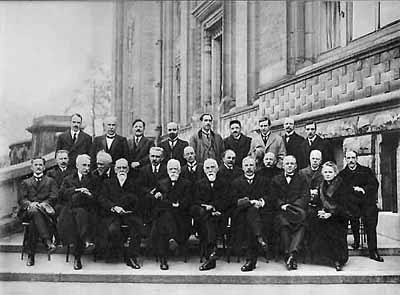 |
Assis au 1er rang de gauche à droite : A.A. Michelson, P. Weiss, M. Brillouin, E. Solvay, H.A. Lorentz, E. Rutherford, R.A. Millikan, Madame Curie; Deuxième rang de gauche à droite : M. Knudsen, J. Perrin, P. Langevin, O.W. Richardson, J. Larmor, K. Kamerlingh Onnes, P. Zeeman, M. De Broglie; Debout de gauche à droite : W.L. Bragg, E. Van Aubel, W.J. De Haas, E. Herzen, C.G. Barkla, P. Ehrenfest, M. Siegbahn, J.E. Verschaffelt, L. Brillouin |
|
Cliquez sur la photo pour l'agrandir
|
||
|
Third Solvay Converence 1921, Brussels, |
||
|
Premier Conseil de Chimie
|
First Chemistry Conference
|
|
| 1922 |
Assis au 1er rang de gauche à droite : Ch. Mouren, F.W. Aston, W.H. Bragg, H.E. Armstrong, W. Pope, E. Solvay, A. Haller, S. Arrhenius, F. Soddy; Deuxième rang de gauche à droite : M. Delepine, E. Bulmann, G. Chavanne, H. Wuyts, O. Dony-Henault, J.M. Lowry, F. Sivarts, G. Urbain, Ch. Mariguin, J. Perrin, E. Herzen, L.Flamache, F.M. Jaeger, E. Hannon, A. Debierne, Aug. Piccard, H. Rupe, A.. Berthoud, R.H. Pickard |
|
|
Cliquez sur la photo pour l'agrandir
|
||
|
First Solvay Chemistry Conference 1922 |
||
|
Conductivité électrique des métaux
et problèmes relatifs
|
Electrical Conductivity of Metals and related problems
|
|
| 1924 |
Assis au 1er rang de gauche à droite : E. Rutherford, Madame Curie, E.H. Hall, H.A. Lorentz, W.H. Bragg, M. Brillouin, W.H. Keesom, I. Van Aubel; Deuxième rang de gauche à droite : P. Debye, A. Joffe, O. W. Richardson, W. Broniewski, W. Rosenhain, P. Langevin, G. deHevesy; Debout de gauche à droite : L. Brillouin, E. Henriot, Th. Dedonder, H.E.G. Bauer, E. Herzen, Aug. Piccard, E. Schrodinger, P.W. Bridgman, J. Verschaffelt |
|
|
Cliquez sur la photo pour l'agrandir
|
|
|
|
Fourth Solvay Converence 1921, Brussels, |
||
|
Electrons
et Photons
|
Electrons
and Photons
|
|
| 1927 |
1er rang de gauche à droite : I. Langmuir, M. Planck, M. Curie, H. A. Lorentz, A. Einstein, P. Langevin, C. E. Guye, C. T. R. Wilson, O. W. Richardson. 2ème rang de gauche à droite : P. Debye, M. Knudsen, W. L. Bragg, H. A. Kramers, P. A. M. Dirac, A. H. Compton, L. V. de Broglie, M. Born, N. Bohr. Debout de gauche à droite : A. Piccard, E. Henriot, P. Ehrenfest, E. Herzen, T. De Donder, E. Schroedinger, E. Verschaffelt, W. Pauli, W. Heisenberg, R. H. Fowler, L. Brillouin. |
|
|
Cliquez sur la photo pour l'agrandir
|
Voir une vidéo | |
| This photograph of well-known scientists was taken at the international Solvay Conference in 1927. Among those present are many whose names are still known today. |
We have spent a considerable amount of time developing the modern atomic theory using the vehicle of history to tie the whole picture together. It is often been said that we stand on the shoulders of giants and this is never more true when we are talking about the atomic theory. As a farewell to this portion of the course I thought it would be appropriate to present you with the photograph of the participants in the 1927 Solvay conference on Quantum Mechanics. It is a remarkable collection of talent and I believe you now know a good bit about at least nine of these people. It is important to remember that they were normal, ordinary people. Smart, but no smarter than most of you in the class. Many, if not most of them showed no particular sign of brilliance as children or young adults. Some did miserably in school. Many were excentric. If anything set them apart from other people it was their ability to focus on a problem and work at it in the face of frustration and failure. I have every reason to believe that some of you will appear in such a photograph (or hologram) in the future. |
|
|
Magnétisme
|
||
| 1930 | Assis de gauche à droite : Th. De Donder,
P. Zeeman, P. Weiss, A. Sommerfeld, M.
Curie, P. Langevin,
A. Einstein, O. Richardson,
B. Cabrera, N. Bohr, W. J. De Haas Debout de gauche à droite : E. Herzen, É. Henriot, J. Verschaffelt, C. Manneback, A. Cotton, J. Errera, O. Stern, A. Piccard, W. Gerlach, C. Darwin, P.A.M. Dirac, E. Bauer, P. Kapitsa, L. Brillouin, H. A. Kramers, P. Debye, W. Pauli, J. Dorfman, J. H. Van Vleck, E. Fermi, W. Heisenberg |
|
|
La structure et propriétés
du noyau atomique
|
The Stucture and property
of Atomic Nucleus
|
|
| 1933 |
Assis de gauche à droite : Schrodinger, Joliot, Bohr, Joffe, Curie, Langevin, Richardson, Rutherford, DeDonder, M. deBroglie, L. deBroglie, Meitner, Chadwick; Debout de gauche à droite : Henriot, Perrin, Joliot, Heisenberg, Kramers, Stahel, Fermi, Walton, Dirac, Debye, Mott, Cabrera, Gamow, Bothe, Blackett, Rosenblum, Errera, Bauer, Pauli, Verschaffelt, Cosyns, Herzen, Cockcroft, Ellis, Peierls, Piccard, Lawrence, Rosenfeld |
|
|
Cliquez sur la photo pour l'agrandir
|
7th Solvay Conf. 1933 | |
|
Particules élémentaires
|
Elementary Particles
|
|
| 1948 |
Assis de gauche à droite : Cockcroft, Tonnelat, Schroedinger, Richardson, Bohr, Pauli, Bragg, Meitner, Dirac, Kramers, DeDonder, Heitler, Verschaffelt ; Deuxième rang de gauche à droite : Scherrer, Stahel, Kelin, Blackett, Dee, Blcoh, Frisch, Peierls, Bhabha, Oppenheimer, Occhialini, Powell, Casimir, deHemptinne ; Troisième rang de gauche à droite : Kipfer, Auger,
Perrin, Serber, Rosenfeld, Ferretti,
Moller, Leprince-Ringuet ; |
|
|
Cliquez sur la photo pour l'agrandir
|
8th Solvay Conf. 1948 | |
|
État solide
|
Solid State
|
|
| 1951 |
Assis de gauche à droite : Crussaro, N.P. Allen, Cauchois, Borelius, Bragg, Moller, Sietz, Hollomon, Frank; 2ème rang de gauche à droite : Rathenau, Koster, Rudberg, Flamache, Goche, Groven, Orowan, Burgers, Shockley, Guinier, C.S. Smith, Dehlinger, Laval, Henriot; 3ème rang de gauche à droite : Gaspart, Lomer, Cottrell, Homes, Curien |
|
|
Cliquez sur la photo pour l'agrandir
|
Ninth Solvay Conf. 1951 | |
|
Neuvième Conseil de Chimie
|
Ninth Chemistry Conference
|
|
| 1953 | ||
|
Cliquez sur la photo pour l'agrandir
|
||
|
Les électrons dans les métaux
|
Electrons in Metals
|
|
| 1954 |
Assis de gauche à droite : Mendelssohn, Frohlich, Pines, Moller, Pauli, Bragg, Mott, Neel, Meissner, MacDonald, Shull, Friedel; Debout de gauche à droite : Gorter, Kittel, Matthias, Prigogine, Onsager, Pippard, Smit, Fumi, Jones, vanVleck, Lowdin, Seeger, Kipfer, Goche, Balasse, Geheniau |
|
|
Cliquez sur la photo pour l'agrandir
|
Tenth Solvay Conf. 1954 | |
|
La structure et l'évolution de l'univers
|
The Structure and Evolution of the Universe
|
|
| 1958 |
Assis de gauche à droite : McCrea, Oort, Lemaitre, Gorter, Pauli, Bragg, Oppenheimer, Moller, Shapley, Heckmann; Debout de gauche à droite : Klein, Morgan, Hoyle, Kukaskin, Ambarzumian, van de Hulst, Fierz, Sandage, Baade, Schatzman, Wheeler, Bondi, Gold, Zanstra, Rosenfeld, Ledoux, Lovell, Geneniau |
|
|
Cliquez sur la photo pour l'agrandir
|
Eleventh Solvay Conf. 1958 | |
|
Théorie des champs quantiques
|
Quantum Field Theory
|
|
| 1961 |
Solvay Conference, 1961. Appraisal of current state of quantum electrodynamics; |
|
|
Vingt-et-unième Conseil de Chimie
|
||
| 2007 | ||
|
Vingt-deuxième Conseil de Chimie
|
||
|
2010
|
||
|
Le monde quantique
|
The theory of the quantum world
|
|
| 2011 |
David
J. Gross (sa biographie sur le site des prix Nobel) a participé
à cette session. Sa photo
ici. Chapman University Yakir Aharonov physicien quantique , Ph.D., ont assisté à la conférence Solvay 25e intitulée «Le monde quantique " 19 au 22 octobre à Bruxelles , en Belgique. Ce fut le 100e anniversaire de la conférence la plus célèbre de la physique , dont les membres se sont réunis à Solvay environ tous les quatre ans depuis la première conférence .
|
|
|
à suivre
|
